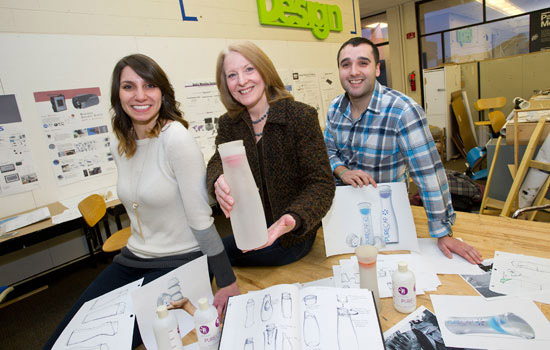Collaboration spawns sustainable business venture
Industrial design alumni work with entrepreneur to design innovative laundry cleaner
A. Sue Weisler
PureCap Laundry LLC is on its way toward revolutionizing laundry cleaning. From left, Katherine Sears ’12, Laura Weller-Brophy and Dom Colaprete ’12.
When recent Rochester Institute of Technology graduates Katherine Sears and Dom Colaprete were approached last year by a Rochester-area entrepreneur with an idea for their senior project, neither of them imagined that it would turn into a full-fledged business venture after they graduated. PureCap Laundry LLC, as the company is called, is now on its way toward revolutionizing laundry cleaning.
PureCap works by simplifying the way in which the cleaner is created and used. The dry cleaner mix is stored in a cap. The consumer fills a specially designed clear bottle with hot water up to a fill line, then screws on the cap containing the dry mix. After shaking the bottle so that the cleaner dissolves in the water, it can be poured into a washing machine with dirty clothes. The custom bottles are designed to hold cleaner for 8-16 loads, depending on the size of the bottle.
The entrepreneur, Laura Weller-Brophy, says that one of the benefits of PureCap is that it limits the amount of cleaning product that gets used and prevents wasteful excess.
“If you were to wash your clothes with just water, there’s a good chance that you would see detergent suds end up in the washing machine,” she says. “That residue comes out of the clothing because most people use too much cleaner. You might be wearing your detergent every day.”
The collaboration began when Weller-Brophy approached Alex Lobos, an assistant professor of industrial design at RIT. Weller-Brophy was looking for someone to design packaging for her innovative laundry cleaner mix that she was developing. Lobos connected her with Sears and Colaprete, who eagerly accepted the project.
“Laura has really valued our opinions throughout the project and she has helped us to become a strong team,” says Sears. Colaprete and Sears, who both graduated from RIT in 2012 with degrees in industrial design, have been integral to the development of PureCap, handling many of the responsibilities of design, marketing, branding and creating the website.
Utilizing facilities in RIT’s industrial design department as well as Student Innovation Hall, the group designed packaging for PureCap with the hopes of making it easier to carry than most detergent bottles.
“Current laundry detergent bottles are typically very large and heavy,” says Weller-Brophy. “We wanted to make something that was small and light.”
The bottle is designed to appeal to a younger demographic, including college students, who often have to travel to clean their laundry. The bottle can be conveniently carried in the drink holder of a backpack and many other small places. Packaging and transportation costs are substantially lower than other laundry cleaners, as are shelf space requirements in stores and homes. The bottle is also easy to use for people with arthritis or carpal tunnel syndrome, as it requires less grip strength to hold than a traditional detergent bottle.
PureCap also addresses sustainability issues. The bottle is completely reusable—only the caps need to be purchased again, which greatly reduces the amount of plastic waste. Additionally, it contains only essential cleaning ingredients—no harsh chemicals. It also comes with a complete list of the ingredients on the bottle, something that Weller-Brophy says most detergents don’t include. It is intended to be gentle on skin and on the environment.
In addition to the use of RIT’s facilities, the trio used last year’s Imagine RIT: Innovation and Creativity Festival to gauge potential customer response to their nascent product.
“We’ve gotten a lot of feedback from students and professors at RIT,” says Colaprete. “Imagine RIT was an important event for us because we were able to demonstrate the product and we got a lot of positive responses.”
The group hopes to secure a business partner or investors in the near future to help them reach their goal of becoming a nationwide product. In the meantime, all three of them work full-time jobs on top of the large amount of time and energy they devote to PureCap Laundry. Sears and Colaprete both work as industrial designers at Ortho Clinical Diagnostics, where they focus on design, usability and human factors testing.
The project has been a positive experience for Weller-Brophy, who says that she would initiate another project like this in a heartbeat.
“It’s so easy to collaborate with students and faculty at RIT,” says Weller-Brophy. “Even little things, such as free visitor parking, demonstrate that they really encourage entrepreneurship and community involvement here. On top of that, the students are producing professional-level work coming out of the gate.”




